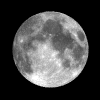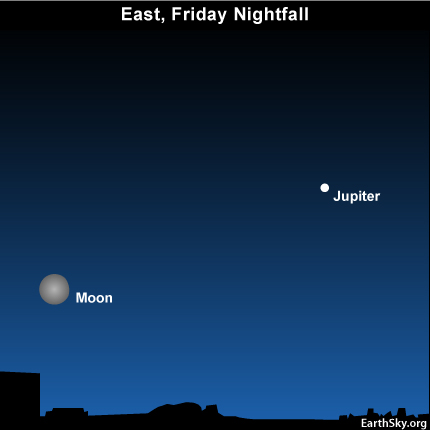Courtesy of EarthSky
A Clear Voice for Science
www.EarthSky.org

 If you live at mid or far northern latitudes, the Harvest Moon and the blazing planet Jupiter will shine from dusk until dawn for yet another night. That is in spite of the fact that the full moon has already passed. (See our September 22 program.) The legendary Full Harvest Moon is famous for ushering in the year’s longest procession of moonlit nights.
If you live at mid or far northern latitudes, the Harvest Moon and the blazing planet Jupiter will shine from dusk until dawn for yet another night. That is in spite of the fact that the full moon has already passed. (See our September 22 program.) The legendary Full Harvest Moon is famous for ushering in the year’s longest procession of moonlit nights.
Why does the Full Harvest Moon in particular – the full moon closest to the autumn equinox – bring about dusk-till-dawn moonlight for several nights in succession? First, we need to understand two different lunar motions. The moon – just like the sun – rises in the east and sets in the west because of the Earth’s rotation. At full moon, the moon shines opposite the sun, so it is on the night of the full moon that the moon is out from sundown to sunup.
There is another lunar motion, caused by the moon’s orbit around Earth. Because the moon travels eastward in its orbit, the moon on the average rises 50 minutes later each day. Yet, the moon’s daily change of position is more sideways than downward around the time of the Full Harvest Moon. Look at where the moon shone relative to Jupiter at this same hour yesterday, and you will get the idea.
Therefore, at mid-northern latitudes, the moon is now rising some 25 minutes (instead of 50 minutes) later daily. At latitudes close to the Arctic Circle, the moon actually rises at the same time for several days in a row. So tonight, watch the Harvest Moon and the planet Jupiter as they, once again, light up the nighttime from dusk until dawn!
Almanac:
September equinox: September 22, 2010, at 9:09 p.m. Mountainl Daylight Time
Full Harvest Moon: September 23, 2010, at 3:17 a.m. MDT
Written by Bruce McClure
Astronomy Picture of the Day from NASA/JPL
U.S. Naval Observator Astronomical Information center
The York County Astronomical Society
 Print This Post
Print This Post








